Students get through the TN Board 12th Bio Zoology Important Questions Chapter 12 Environmental Issues which is useful for their exam preparation.
TN State Board 12th Bio Zoology Important Questions Chapter 12 Environmental Issues
Very short answer questions
Question 1.
Define Pollution.
Answer:
Pollution is defined as any undesirable change in the physical, chemical, and biological characteristics of an environment.
Question 2.
What are pollutants?
Answer:
Pollutants are the agents which cause pollution.
Question 3.
What are the different basic groups of pollutants?
Answer:
The pollutants are classified into two major groups namely Non-degradable and degradable pollutants.
![]()
Question 4.
Name the main sources of carbon monoxide pollution.
Answer:
The main sources of carbon monoxide pollution include Automobile exhausts, fumes from factories and the burning of firewood.
Question 5.
Define SMOG.
Answer:
SMOG is defined as a type of air pollution caused by tiny particles in the air.
Question 6.
Mention any two cost-effective treatments of air pollution?
Answer:
The cost-effective treatment of air pollution includes:
- Growing indoor plants and
- Using high-performance biofilters.
Question 7.
Explain Air Quality Index (AQI).
Answer:
Air Quality Index is the number used by Government agencies to communicate to the public how polluted the air is at a given time.
Question 8.
Name any two examples of the non-point sources of pollutants.
Answer:
- Agriculture chemical run-off.
- Dumping of plastics in water bodies.
![]()
Question 9.
Define Noise pollution.
Answer:
Noise pollution is defined as the sound that is unwanted and undesirable or can disrupt one’s quality of life.
Question 10.
Name the chemicals present in mosquito repellents.
Answer:
The chemicals present in mosquito repellents are:
- DEET (n-n-diethylenetatoluamide)
- Alletrin
Question 11.
Define Biomagnification.
Answer:
Biomagnification is the process in which a non-degradable substance, that enters die – food chain does not get metabolized and instead gets transferred up the tropic levels of the food chain with the magnified level of that substance.
Question 12.
What is ‘4R’?
Answer:
‘4R’ means Refuse, Reduce, Reuse and Recycle. These are the mantra for remedy II for the plastic waste problem.
![]()
Short answer questions
Question 1.
What are plastics? Explain their sources.
Answer:
Plastics are low molecular weight organic polymers, that are not degradable in the natural environment.
The main sources of this plastic include:
- The packaging material used in supermarkets.
- Packing material in retail outlets.
- Manufacturing industries.
- Households, hotels, hospitals, and restaurants, and transport companies.
- In municipal solid waste, plastic waste constitutes a major part.
Question 2.
Recycling and disposal of e-waste involve significant risk – Justify.
Answer:
The recycling and disposal of e-waste may involve risks to the health of workers and communities in developed countries.
- Great care must be taken to avoid unsafe exposure in recycling operations.
- The leading of materials like heavy metals from landfills and incinerator ashes may cause health problems to humans and animals.
Question 3.
How does water pollution affect on the ecosystem?
Answer:
Water pollution generally affects the aquatic ecosystems in the following ways:
- It affects existing riches and habitats.
- It affects the survival of organisms.
- In certain cases, soil fertility is affected, leading to the state of uninhabitable.
- It results in Eutrophication.
![]()
Question 4.
What are three sources of water pollution?
Answer:
The three sources of water pollution are:
- Municipal waste
- Industrial waste
- Agricultural waste
Question 5.
Water pollution disrupts the nature of food chains as well as food webs – Justify.
Answer:
- Pollutants such as lead and cadmium are taken up by primary consumers, where they can be lethal or get accumulated.
- When these animals are consumed by secondary consumers, their pollutants are get enhanced by a process called biomagnification.
- The food chain may get disrupted at any trophic level due to the magnification and accumulation of these chemicals.
Question 6.
Explain the Government Act and regulations to prevent water pollution.
Answer:
- Water Act, 1974, section 17- 40 – Prohibits the pollution of a stream or well by disposal of polluting matter.
- The Central / State pollution control Boards – They have the power to advise the central / state governments on various matters concerned with the prevention and. control of pollution of water.
- The Ministry of Environment, forest and climate change (MoEFCC) is the nodal agency of the central government for planning, promotion, coordination, and overseeing the implementation of India’s environmental and forestry policies and programs.
![]()
Question 7.
How do you control ozone layer depletion?
Answer:
- Phase down or ban the use of CFCs (CFC-free refrigerants).
- The usage of chemicals such as halons and halocarbons ought to be minimized.
- Creating awareness about ozone-depleting agents.
Long answer questions
Question 1.
Give an account of medical waste.
Answer:
Medical waste refers to any waste that contains infectious material generated by hospitals, medical research centers, laboratories, pharmaceutical companies, and veterinary clinics.
Medical’wastes constitute fluid like blood, urine, body parts, and other contaminants. They also include used syringes and needles, culture dishes, glasswares, bandages gloves, scalpels, swabs, and tissues.
Hie social and legal responsibilities of – people working in health care centers are the safe disposal of medical waste.
The disposal methods include incineration, chemical disinfection, autoclaving, encapsulation microwave irradiation. Landfill and burying inside premises as per norms are the final disposal of these wastes.
Question 2.
Describe the prevention methods of water pollution.
Answer:
The followings are the prevention strategies of water pollution:
- Regulate or control pollutant discharge at the point of generation.
- Treatment of wastewater by scientific methods before discharge into municipal treatment sources.
- Setting up of Sewage Treatment Plants (STP) and Effluent Treatment Plants (ETP) where ever needed.
- Regulate or restrict the use of chemical fertilizers and pesticides in agriculture. Create public awareness and involve people in the action plan.
![]()
Question 3.
Enumerate the effects of noise pollution.
Answer:
A link between noise and the health of humans and other organisms was established by USEPA (the United States Environmental Protection Agency). The noise pollution effects are:
- It causes increased stress and tension nervousness, irritability anxiety depression, and panic attacks.
- It also causes peptic ulcers, severe headaches, memory loss.
- Noise pollution from offshore activities and poor activities affects marine animals.
- Noise from firecrackers frightens animals and birds.
- In humans, heart disease, high blood pressure, stress-related illness, sleep disruption, hearing loss, and productivity loss are some of the problems related to noise pollution.
Question 4.
Explain the causes and effects of ozone layer depletion.
Answer:
Causes:
- Anthropogenic activities mainly cause ozone layer depletion.
- Chlorofluorocarbons (CFCs) is the main cause of ozone layer depletion by releasing excess chlorine and bromine. Other ozone-depleting substances are hydrobromic fluorocarbons and methyl bromide.
Effects:
- It allows UY rays to penetrate into the atmosphere, resulting in premature aging of skin and wrinkling of the skin.
- It may cause suppression of the immune system.
- It causes skin cancer (melanoma) and chronic effects leading to eye damage.
- The free radicals and reactive oxygen and photons can damage DNA itself.
![]()
Choose the correct answers:
1. Match the following:
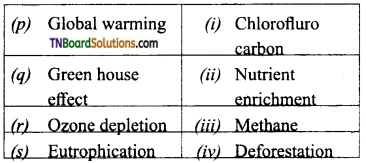
(a) (p)-(iv); (q)-(iii); (r)-(ii); (s)-(i)
(b) (p)-(iv); (q)-(iii); (r)-(i); (s)-(ii)
(c) (p)-(ii); (q)-(i); (r)-(iv); (s)-(iii)
(d) (p)-(iii); (q)-(iv); (r)-(ii); (s)-(i)
Answer:
(b) (p)-(iv); (q)-(iii); (r)-(i); (s)-(ii)
2. Match the following:
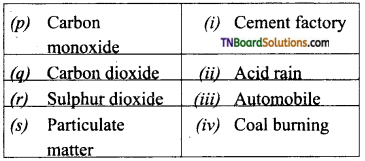
(a) (p)-(iv); (q)-(iii); (r)-(ii); (s)-(i)
(b) (p)-(ii); (q)-0); (r)-(iv); (s)-(iii)
(c) (p)-(iii); (q)-(iv); (r)-(ii);(s)-(i)
(d) (p)-(iv); (q)-(iii); (r)-(i); (s)-(ii)
Answer:
(c) (p)-(iii); (q)-(iv); (r)-(ii); (s)-(i)
![]()
3. Match the following:
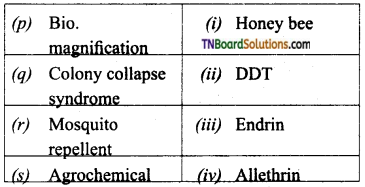
(a) (p)-(ii); (q)-(i); (r)-(iv); (s)-(iii)
(b) (p)-(iv); (q)-(iii); (r)-(ii); (s)-(i)
(c) (p)-(iii); (q)-(iv); (r)-(ii); (s)-(i)
(d) (p)-(iv); (q)-(iii); (r)-(i); (s)-(ii)
Answer:
(a) (p)-(ii); (q)-(i); (r)-(iv); (s)-(iii)
4. Match the following:
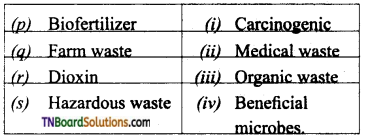
(a) (p)-(iv); (q)-(i); (r)-(ii); (s)-(iii)
(b) (p)-(iv); (q)-(iii); (r)-(i); (s)-(ii)
(c) (p)-(iv); (q)-(iii); (r)-(ii); (s)-(i)
(d) (p)-(ii); (q)-(i); (r)-(iv); (s)-(iii)
Answer:
(b) (p)-(iv); (q)-(iii); (r)-(i); (s)-(ii)
5. Medical waste is classified under:
(a) Solid waste
(b) Organic waste
(c) Hazardous waste
(d) Chemical waste
Answer:
(c) Hazardous waste
![]()
6. Which of the following is an anaerobic ‘ process?
(a) Vermicomposting
(b) Biogas generation
(c) Segregation
(d) Nitrification
Answer:
(b) Biogas generation
7. How much garbage is collected per day from Chennai city?
(a) 5400 MT
(b) 4800 MT
(c) 2400 MT
(d) 6800 MT
Answer:
(a) 5400 MT
8. The method not used in the physical methods of waste treatment.
(a) Flotation
(b) Chlorination
(c) Sedimentation
(d) Filteration
Answer:
(b) Chlorination
9. Choose the odd man out:
(a) Nammalvar
(b) Sultan Md. Ismail
(c) Thiagarajan
(d) Jadav Payeng
Answer:
(c) Thiagarajan
![]()
10. Identify the odd one:
(a) Food waste
(b) Paper waste
(c) Plastic waste
(d) Organic waste
Answer:
(c) Plastic waste
11. Choose the odd one:
(a) Dilute and disperse
(b) Segregation and treatment
(c) Delay and decay
(d) Concentrate and confine
Answer:
(a) Dilute and disperse
12. Find out the odd one:
(a) Bandages
(b) Sealpels
(c) Glasswares
(d) Swabs and tissues
Answer:
(b) Sealpels
13. Which of the following is a correct pair?
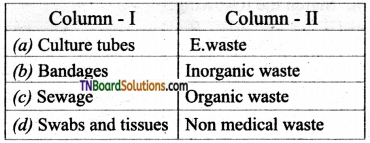
Answer:
(c)
![]()
14. Choose the incorrect pair:
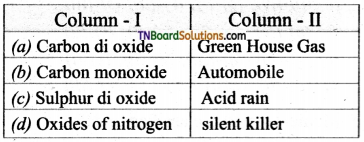
Answer:
(d)
15. Find out the correct pair:
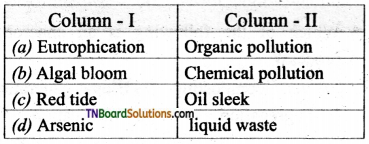
Answer:
(a)
16. Indicate the incorrect pair:
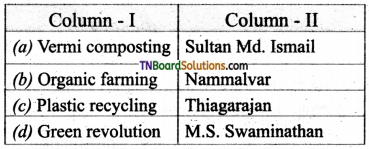
Answer:
(c)
17. Assertion: Organic farming creates an eco-friendly pollution-free environment.
Reason: In organic farming, only natural and organic agro-inputs are used.
(a) Both Assertion and Reason are correct, Reason is the correct explanation of Assertion.
(b) Both Assertion and Reason are correct, Reason is not the correct explanation of Assertion.
(c) Assertion is correct, Reason is not correct.
(d) Assertion is not correct, Reason is correct.
(e) Both Assertion and Reason are not correct.
Answer:
(a) Both Assertion and Reason are correct, Reason is the correct explanation of Assertion.
![]()
18. Assertion: DDT concentration is more in fish-eating birds than the actual concentration of the aquatic system.
Reason: This is due to a phenomenon called Biomagnification.
(a) Both Assertion and Reason are correct, Reason is the correct explanation of Assertion.
(b) Both Assertion and Reason are correct, Reason is not the correct explanation of Assertion.
(c) Assertion is correct, Reason is not correct.
(d) Assertion is not correct, Reason is correct.
(e) Both Assertion and Reason are not correct.
Answer:
(a) Both Assertion and Reason are correct, Reason is the correct explanation of Assertion.
19. Assertion: The permissible limit of noise in commercial areas is 65 decibels during the day and 45 decibels during the night.
Reason: The threshold pain of noise pollution is 120 decibels.
(a) Both Assertion and Reason are correct, Reason is the correct explanation of Assertion.
(b) Both Assertion and Reason are correct, Reason is not the correct explanation of Assertion.
(c) Assertion is correct, Reason is not correct.
(d) Assertion is not correct, Reason is correct.
(e) Both Assertion and Reason are not correct.
Answer:
(d) Assertion is not correct, Reason is correct.
20. Assertion: Acid rain is caused by Sulphur dioxide and nitric oxide.
Reason: During rain, the precipitation contains acidic components such as sulphuric acid or nitric acid.
(a) Both Assertion and Reason are correct, Reason is the correct explanation of Assertion.
(b) Both Assertion and Reason are correct, Reason is not the correct explanation of Assertion.
(c) Assertion is correct, Reason is not correct.
(d) Assertion is not correct, Reason correct.
(e) Both Assertion and Reason are not correct.
Answer:
(b) Both Assertion and Reason are correct, Reason is not the correct explanation of Assertion.
![]()
21. Which of the following statement is correct?
(a) Thinning of the stratospheric ozone layer is caused by all GHGs.
(b) Thinning of the stratospheric ozone layer is caused by CO2 emission.
(c) Thinning of the stratospheric ozone layer is caused by Cf Cs.
(d) None of the above.
Answer:
(a) Thinning of the stratospheric ozone layer is caused by all GHGs.
22. Choose the incorrect statement:
(a) Trees are the best remedy for urban particulate matter.
(b) Forests act as sink for CO2.
(c) Forests act as lungs of planet.
(d) All the above statements are not correct.
Answer:
(d) All the above statements are not correct.
23. Indicate the correct statement:
(a) Noise pollution can cause severe stomach ache.
(b) The threshold pain of noise pollution is about 120 decibels.
(c) Marine animals are not affected by noise pollution.
(d) None of the above.
Answer:
(b) The threshold pain of noise pollution is about 120 decibels.
![]()
24. Choose the incorrect statement:
(a) Limit generation is the most important consideration in managing radioactive wastes.
(b) Dilution and dispersion are adopted for wastes having high radioactivity.
(c) Much of the radioactivity in nuclear reactors and accelerator is very short-lived.
(d) Concentrate and confine process is another method of radioactive material disposal.
Answer:
(b) Dilution and dispersion are adopted for wastes having high radioactivity.